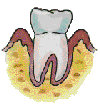
Tooth Pain after Teeth Whitening
The increased popularity of tooth whitening in recent years has also increased the number of tooth pain incidents related with the whitening treatments.
About 30 to 50% of the people who use whitening products experience some degree of tooth sensitivity pain or/and gum irritation pain during the course of their teeth bleaching treatments.
The risk of experiencing some sort of pain or discomfort as a side effect of tooth whitening seems to be mainly related to the concentration and the duration of exposure to the bleaching agent. These conditions usually occur during or immediately after the teeth bleaching and normally disappear after a few days.
1. Tooth Sensitivity Pain Caused by Teeth Whitening
Tooth sensitivity is called the condition when a cold or hot, sweet or sour stimuli in the mouth or even air or touch causes an intense pain to some teeth. All bleaching gels cause some degree of tooth sensitivity pain, but the level of discomfort is not the same for everyone. This is normal and an expected side effect. Sensitive teeth pain caused by tooth whitening is a temporary condition that usually disappears within 48 hours after the whitening treatment is stopped.
If you do experience tooth sensitivity pain, you can reduce or eliminate the symptoms by:
- Using the whitening tray or strips for a shorter period of time (15 minutes instead of the 30 minutes usually recommended by the manufacturer) or only once instead of two times a day.
- Stopping the teeth whitening treatment for some days. Usually it will relieve the symptoms in one or two days. The bleaching results are additive so discontinuing the treatment for a few days will not affect the final result, it will simply take longer.
- Replace the whitening product that you use with another with lower concentration of bleaching agent, at least until the symptoms subside.
- Visit your dentist for a dental examination. In many cases the reason of tooth pain is an undetected tooth decay that makes the tooth vulnerable to the bleaching agent.
- Use a toothpaste for sensitive teeth pain relief for the period during and a little after the bleaching treatment. Modern desensitizing toothpastes contain special ingredients such as potassium nitrate with very good results in fighting the tooth sensitivity symptoms.
- If over the counter desensitizing toothpastes prove ineffective, you can ask your dentist to prescribe a special desensitizing gel with high fluoride concentration that helps to remineralize the enamel and relieve tooth sensitivity pain.
2. Gum Irritation Pain After Teeth Whitening
Gum irritation is another common cause of pain and discomfort that is experienced after a tooth whitening treatment. Gum irritation may be chemically or physically induced teeth whitening problem. Main causes are:
- Bleaching trays that do not fit properly are a common source of gum irritation because they can traumatize the soft tissues of the gums causing pain at the points of contact. The condition is usual after using at home tray based whitening systems. Professional tray based whitening rarely causes similar problems because the trays are fabricated specifically for the person who will wear them. These ‘custom’ made trays help to minimize the possibility of gum irritation caused by the tray itself. Whitening strips that use a thin, flexible plastic strip to deliver the bleaching agent are also unlikely to cause any trauma to gums.
- The reaction of the peroxide based whitener, that is used in most kinds of whitening systems, with the soft tissues of the mouth is the second source of gum irritation and pain. Unlike the physically caused gum irritation, which is a problem of tray based systems mainly, this type of chemical irritation seems to be common in all types of tooth whitening methods because it is caused by the whitening agent itself.
Usually the pain due to gum irritation is only mild in severity without causing serious discomfort. If the problem is caused by not well fitting bleaching trays prefer the use of ‘custom’ made trays. If you already use a professionally made tray and you still have problems, visit your dentist to adjust their shape to fit the shape of your gums.
If gum irritation is caused by the bleaching agent :
- Discontinue the use for some days or use the product for less time.
- Be more careful not to place too much gel in the trays because it will overflow and come in closer touch with your gums.
- Position the trays or the strips in a way that will minimize the contact of the gums with the peroxide whitener.
- After removing the bleaching tray or strip, wash your gums to remove any residues of the bleaching agent.
- If you have gum disease it is expected that you will experience gum irritation problems during tooth bleaching. Gum disease has to be treated before starting a tooth whitening procedure.
3. Teeth Pain due to Tooth Whitening Addiction
'Whitening addiction’ is a term used to describe a condition characterized by repeated overuse of whitening products in pursue of a super bright white tooth color. Beside the fact that very white teeth look unnatural and may worsen your aesthetic appearance (as the others perceive it), the main problem is that the results may be catastrophic for the health of your teeth causing dental erosion. Overuse of whitening products will gradually wear away the enamel on the surface of the teeth, causing irreversible damage to the teeth and/or gums. Teeth whitening addiction is almost always related with tooth pain as the teeth become over-sensitive because of the destruction of tooth enamel and the constant irritation of the gums.
How to Avoid Pain From Teeth Whitening
To minimize the risk of experiencing pain or discomfort after tooth whitening, you should:
- Visit your dentist for a complete dental examination before using any over the counter tooth whitening product. The dentist will check for any existing conditions and advise you whether or not your teeth are suitable for tooth bleaching and which method is best for you.
- Follow carefully the instructions on the package of over the counter whitening systems.
- Do not overuse whitening products. Never use the bleaching products for more time or more often than directed in an effort to get better or faster results because you will possibly end up with damaged teeth.
- Prefer the in-office professional tooth whitening. The bleaching procedure is always safer if done under the supervision of a dentist. The dentist will also help you to set realistic expectations and avoid overuse of whitening products.

 Dental Insurance
Dental Insurance Sensitive Teeth Pain
Sensitive Teeth Pain Toothache Remedies
Toothache Remedies Toothache Medicines
Toothache Medicines